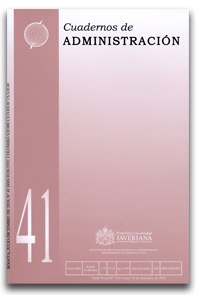Quantificação do risco operacional em entidades financeiras na Colômbia
##plugins.themes.bootstrap3.article.details##
O propósito do artigo é responder se é possível implementar modelos de medição avançada para quantificar risco operacional em instituições financeiras na Colômbia. Dessa forma, comparam-se dois modelos desde o enfoque de distribuição de perdas agregadas, através de simulações de Monte Carlo. Este enfoque se baseia na teoria de riscos de seguros para obter a distribuição de prejuízo e estimar o valor em risco em 99,9% em um período de um ano. O primeiro modelo, proposto por Böcker e Klüppelberg, é obtido usando uma fórmula fechada quando as perdas se ajustam a uma distribuição sub-exponencial. O outro modelo está baseado na teoria do valor extremo. Ao aplicá-lo às perdas por risco operacional de 2008 das entidades financeiras colombianas, encontra-se que o prejuízo máximo esperado para 99,9% dos melhores casos é de 3,2 bilhões de pesos, considerado “razoável” de acordo com os ativos.
operating risk, aggregate loss distribution approach, subexponential distribution, extreme value theoryriesgo operativo, enfoque de distribución de pérdidas agregadas, distribución subexponencial, teoría del valor extremorisco operacional, enfoque de distribuição de perdas agregadas, distribuição sub-exponencial, teoria do valor extremo
Balkema, G. and Embrechts P. (2007). High risk scenarios and extremes: A geometric approach. s. l.: Zürich Lectures in Advanced Mathematics-European Mathematical Society.
Beirlant, J.; Goegebeur, Y.; Segers, J. and Teugels, J. (2004). Statistics of extremes: theory and applications. New York: John Wiley & Sons.
Beirlant, J.; Dierckx G.; Goegebeur, Y. and Matthys, G. (1999). Tail index estimation and an exponential regression model. Extremes, 2, 177-200.
Böcker, K. and Klüppelberg, C. (2005). Operational VaR: a closed-form approximation. RISK Magazine, December, 90-93.
Multivariate models for operational risk. (2006). Munich: Munich University of Technology.
De Fontnouvelle, P.; DeJesus-Rueff, J. and Rosengren, E. (2006). Capital and risk: New evidence on implications of large operational losses. Journal of Money, Credit and Banking, 38, 1819-1846.
De Fontonouvelle, P.; Rosengren, E. and Jordan, J. (2004). Implications of alternative operational risk modelling techniques. Unpublished paper. Boston: Federal Reserve Bank.
Degen, M.; Embrechts, P. and Lambrigger, D. (2007). The quantitative modeling of operational risk: between g-and-h and EVT. ASTIN Bulletin, 37, 265-291.
Dutta, K. and Perry, J. (2006). A tale of tails: An empirical analysis of loss distribution models for estimating operational risk capital. Working Paper No. 06-13. Boston: Federal Reserve Bank.
Embrechts, P. (2009). Linear correlation and EVT: properties and caveats. Journal of Financial Econometrics, 7 (1), 30-39.
Klüppelberg, C. and Mikosch, T. (1997). Modelling extremal events for insurance and finance. Berlin: Springer.
Evans, J. R. and Olson, D. L. (2002). Introduction to Simulation and Risk Analysis (2nd ed.). New Jersey: Prentice Hall.
Huisman, R.; Koedijk, K.; Kool, C. and Palm, F. (2001). Tail-index estimates in small samples. Journal of Business and Economic Statistics, 19, 208-216.
Jobst, A. (2007). The treatment of operational risk under the New Basel framework: Critical issues. Journal of Banking Regulation, 8 (4), 316-352.
Kraujalis, S.; Karpaviciene, E. and Aurelijus, C. (2006). The specifics of operational risk assessment methodology recommended by Basel II. Engineering Economics, 3 (48). Recuperado el 25 de noviembre de 2010, de http://www.ktu.lt/lt/mokslas/zurnalai/inzeko/48/1392-2758-2006-3-48-07.pdf
McNeil, A. J.; Frey, R. and Embrechts, P. (2005). Quantitative risk management: concepts, techniques and tools. Princeton: Princeton University Press.
Mikosch, T. (2004). Non-life insurance mathematics: an introduction with stochastic processes. Berlin: Springer Verlag.
Moosa, I. (2007). Operational risk: a survey. Financial Markets, Institutions & Instruments, 16 (4), 167-200.
Mora, A. (2009). Un estudio comparativo de algunos estimadores del índice de valor extremo. Bogotá: Colegio de Estudios Superiores de Administración (CESA).
Moscadelli, M. (2004). The modelling of operational risk: Experience with the analyisis of the data collected by the Basel Committee. Banca d'Italia, Temi di discussione del Servizio Studi, 517, July.
Neslehová, J.; Chávez-Demoulin, V. and Embrechts, P. (2006). Infinite-mean models and the LDA for operational risk. Journal of Operational Risk, 1 (1), 3-25.
Reiss, R.-D. and Thomas, M. (1997). Statistical analysis of extreme values. Basel: Brikhäuser.
Wei, R. (2006). Quantification of operational losses using firm-specific information and external databases. Journal of Operational Risk, 1 (4), 3-34.


